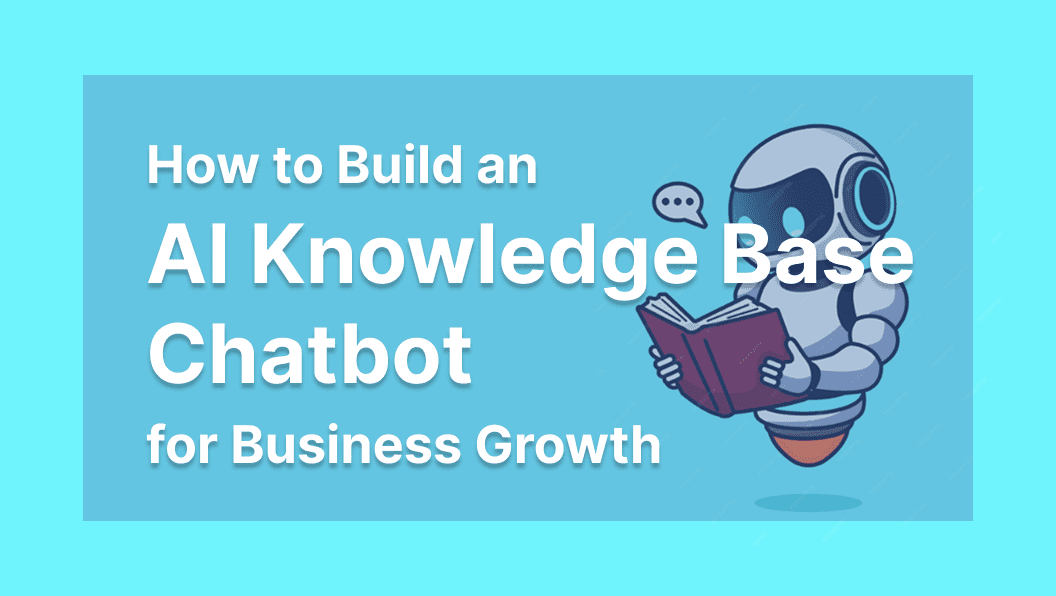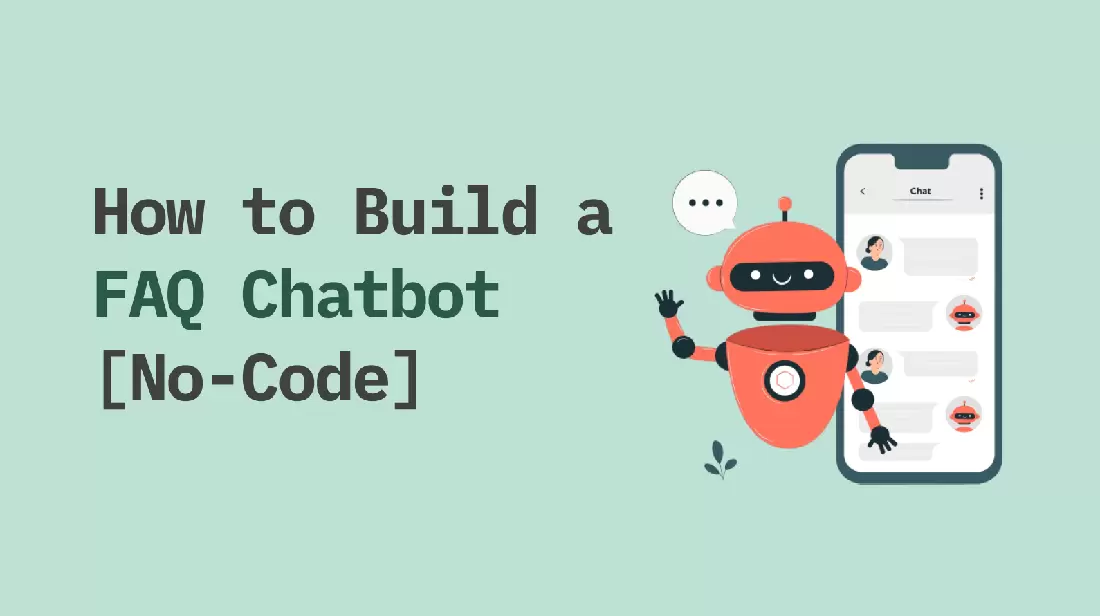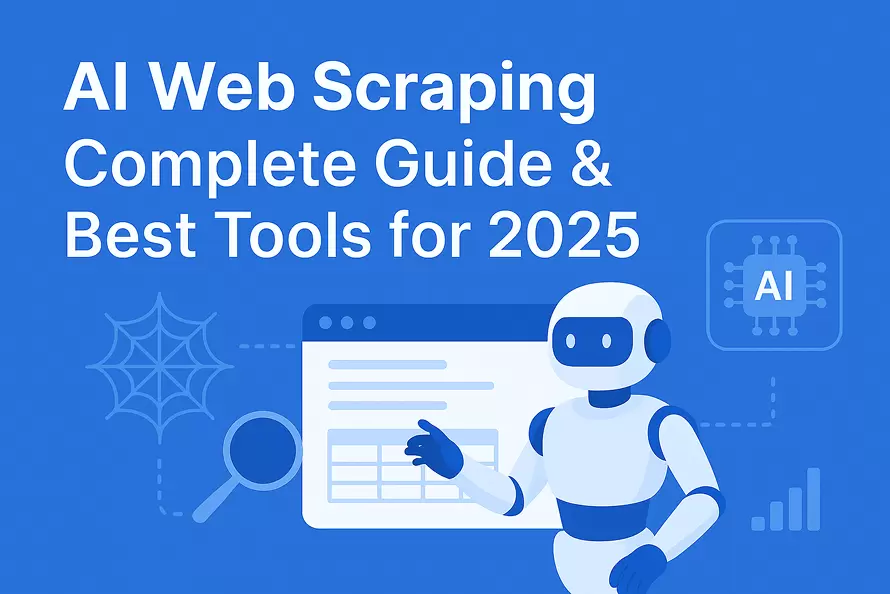Imagine a product team at a fast-growing e-commerce company. They’re preparing to launch a new virtual assistant that can handle customer service queries across multiple channels; voice, chat, and in-app messaging. The deadline is tight, and the team is exploring tools that can help them build a conversational agent without depending heavily on developers.
That’s when Voiceflow AI comes into the conversation!
Whether you’re an independent developer, a UX designer, or an enterprise looking to build scalable AI agents for customer engagement or internal workflows, Voiceflow AI has become one of the go-to platforms in this space. It offers a powerful visual editor that lets teams design, test, and deploy AI voice and chat agents with relative ease. And with a growing focus on collaborative workflows and enterprise-ready infrastructure, Voiceflow is evolving beyond a prototyping tool and stepping into serious AI product development.
But is it the right fit for you or your organization in 2025?
In this detailed 2025 review, we’ll break down everything you need to know about Voiceflow AI, from its key features and pricing structure to its current limitations and how it compares with other tools on the market.
If you’re considering a conversational AI platform, especially for enterprise-scale use cases, this guide will help you evaluate whether Voiceflow is worth the investment, or if one of the Voiceflow alternatives might better suit your needs.
Here’s what we’ll be covering:
- What makes Voiceflow AI popular in the conversational design space
- A breakdown of its free and paid pricing plans—including what’s included at each level
- Where it shines and where it falls short for professional and enterprise use
- The best Voiceflow alternatives available in 2025—and which one stands out the most for businesses
Let’s first dive into what Voiceflow AI really is, and how it’s being used today.
What Is Voiceflow AI? Features, Pros, and Cons

Voiceflow AI
is a user-friendly, no-code platform that allows individuals and teams to
design, build, and launch intelligent conversational agents—whether for voice
applications or text-based chat interfaces. Originally launched to support
developers building Alexa Skills, Voiceflow has significantly evolved into a
powerful solution for creating multi-channel AI agents that can live on
websites, mobile apps, smart devices, and more.
Another standout aspect of Voiceflow AI is that it caters to both non-technical users and product teams looking to rapidly prototype or launch production-ready AI assistants. You don’t need to write a single line of code; its visual editor lets you build conversational flows, connect external systems, and define how your agent should respond to different user inputs.
It’s used across many industries, from customer support and e-commerce to internal automation and education, and is especially valued for its scalability and collaborative design experience.
Features of Voiceflow AI
Here’s a closer look at some of the platform’s most important features that make it a useful tool for conversational AI development:
1Drag-and-Drop Conversation Builder
Voiceflow’s no-code visual editor is one of its most defining features. It allows you to easily map out conversations using drag-and-drop blocks. This simplifies complex user journeys and makes it easy to update your flow whenever needed, without needing help from a developer.
2Real-Time Team Collaboration
With built-in support for team collaboration, multiple users can work on the same project simultaneously. You can leave comments, track changes through version history, and maintain workflow transparency across design, development, and product teams. This makes it an ideal tool for enterprise teams managing conversational AI projects at scale.
3Integration with External Tools
While Voiceflow AI doesn’t offer native one-click integrations for everything, it does allow you to connect with third-party services via APIs. You can plug in CRMs like HubSpot, databases, spreadsheets, and even payment processors like Stripe to automate workflows, collect data, or process transactions; all within your agent flow.
4Built-In AI Support
Voiceflow comes with AI-powered capabilities, including custom intents, a knowledge base feature for long-form content ingestion, and large language model (LLM) integration. These tools allow your agents to go beyond rule-based responses and handle more natural, free-flowing conversations.
5Test & Debug before Going Live
Another key part of the platform is its ability to test agents in real time. You can simulate live conversations, catch issues, and fine-tune the dialogue before deploying it. Combined with analytics tools, this testing environment helps refine responses and improve user satisfaction.
6Multi-Channel Deployment
You can embed your finished conversational agent on various platforms, including websites, mobile apps, smart speakers, and even telephony services. This flexibility ensures that your AI assistant can meet your audience wherever they are.
Pros of Using Voiceflow AI
- Simple and intuitive visual flow builder; great for beginners and professionals alike
- Ideal for collaborative projects with version control and live editing features
- Works well for both prototyping and deploying production-ready agents
- Free plan available with generous limits to get started quickly
- Built-in AI features including intents, knowledge base, and natural language understanding
- Web widget and telephony support for expanded deployment options
Where Voiceflow AI Falls Short
While it’s a powerful platform, Voiceflow AI does have some limitations to consider:
- Lacks out-of-the-box live chat integration for handoff to human agents
- Analytics are fairly basic compared to enterprise-level conversational analytics platforms
- No direct plug-and-play integrations with common tools; you’ll need API knowledge for most connections
- Might become expensive for teams that need multiple editors or more than a few agent projects
While it’s excellent for mapping out conversational logic and running internal pilots, Voiceflow AI doesn’t yet provide the full deployment support, advanced analytics, or data privacy controls needed for high-stakes industries like banking, insurance, or healthcare. For these sectors, the challenge isn’t just designing an AI assistant; it’s deploying one at scale, measuring outcomes, maintaining performance, and ensuring the solution meets regulatory requirements.
If your organization is looking for more than just a design canvas; if you’re aiming to create, deploy, and scale intelligent agents that actually drive business outcomes, you’ll need a platform built for the full lifecycle of enterprise AI. And this is exactly where many companies begin exploring Voiceflow alternatives that go beyond basic design and offer data-backed automation, robust integrations, and enterprise-grade security.
Solutions like GPTBots have started to stand out in this space and we’ll discuss about this in detail in the coming sections.
Voiceflow AI Pricing Plans (2025): Free vs. Paid Comparison
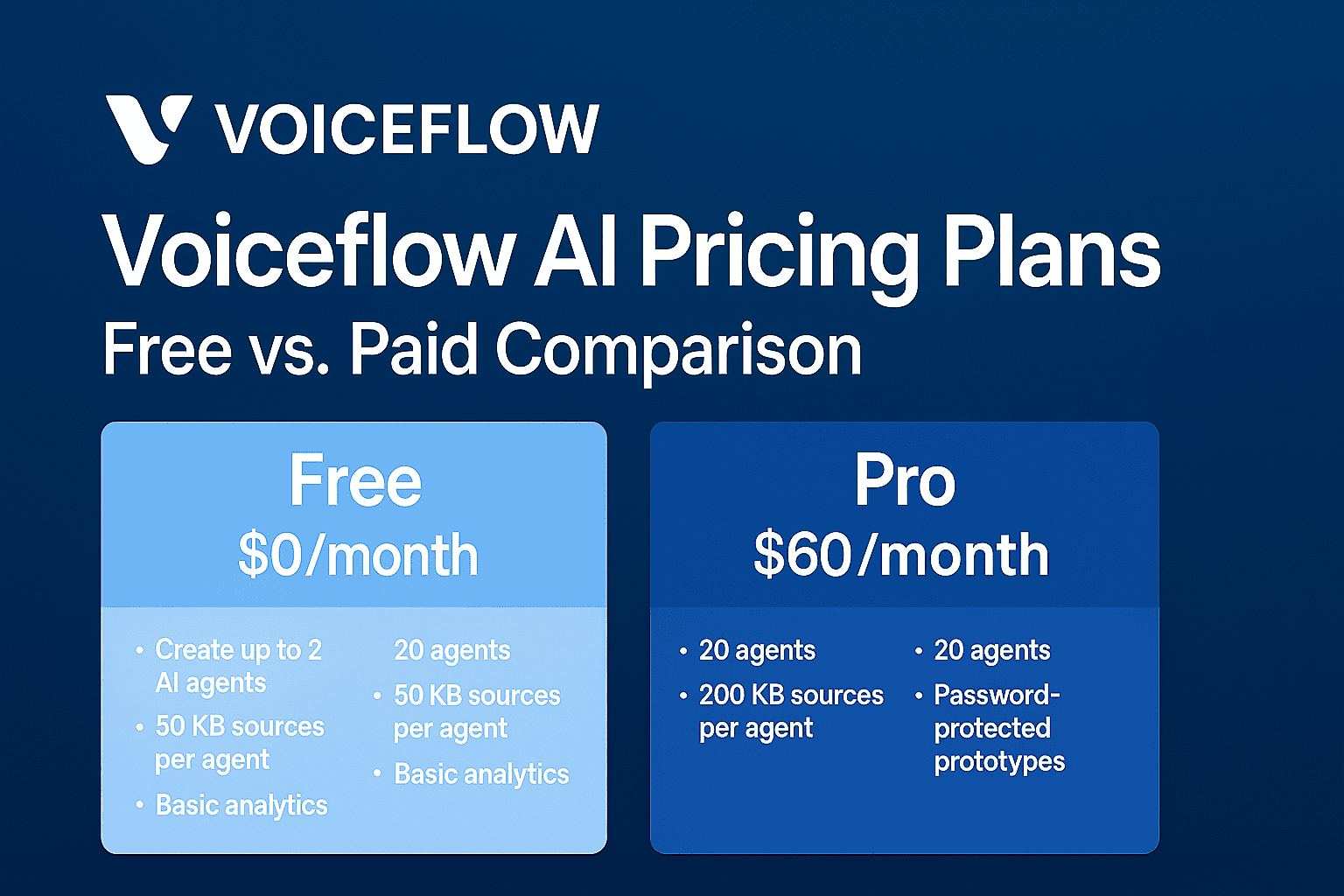
It is very safe to say that understanding the Voiceflow pricing model is essential before you commit to the platform; whether you’re just experimenting with AI agents or planning to build a scalable, enterprise-grade assistant. Voiceflow offers four pricing tiers: Free, Pro, Team, and Enterprise. Each plan unlocks different capabilities that make the platform suitable for a wide range of users, from solo builders to large companies.
But beyond the surface-level costs, there are a few details worth exploring, like usage limits, missing features at lower tiers, and the growing gap between collaborative design and production-ready deployment.
Let’s break it all down.
1. Free Plan
Cost: $0/month
The Free plan is ideal for users who want to test Voiceflow AI without making a financial commitment. It allows you to create up to two agents and experiment with the basic drag-and-drop interface.
What You Get:
- 1 editor seat
- 2 AI agents
- 50 knowledge base sources per agent
- Basic analytics
- 7-day version history
- 1 user persona for testing
This plan is great for learning the platform, but it comes with limited processing power and lacks features needed for larger workflows or real deployments. If you’re serious about using AI agents in a business setting, you’ll quickly outgrow this tier.
2. Pro Plan
Cost: $60/month
The Pro plan steps things up by offering more resources and the ability to work with a teammate. It suits startups, solopreneurs, and agencies building AI assistants for clients.
Key Highlights:
- 2 editor seats
- Up to 20 AI agents
- 200 knowledge base sources per agent
- 30-day version history
- 5 test personas
- Password-protected prototypes
- Access to an analytics dashboard
However, note that even at this level, there are voice interaction limits (e.g., only 5 concurrent calls), which could be a bottleneck during high-traffic periods. Also, advanced security features like SSO are not available here.
3. Team Plan
Cost: $125/month
Designed for medium-sized teams, this tier supports more collaborative work and higher data volumes.
Included in the Plan:
- 5 editor seats
- Unlimited agents
- 5,000 knowledge base sources per agent
- Unlimited test personas
- Unlimited version history
- Priority support via email and chat
- Role-based access (limited)
This plan is ideal for businesses scaling their AI use across departments or customer-facing channels. However, some enterprise-grade needs, like private hosting, full user control, or advanced compliance, still require an upgrade to the Enterprise plan.
4. Enterprise Plan
Cost: Custom pricing (Contact Sales)
If you’re a large organization working in industries like finance, healthcare, or logistics, the Enterprise plan is where Voiceflow AI becomes a tailored solution. This plan offers more control, enhanced performance, and premium support.
Enterprise Features Include:
- Unlimited editors and AI agents
- Private cloud deployment (AWS)
- SAML, SSO, and advanced security controls
- Dedicated customer success manager
- Bring-your-own-LLM options
- Team onboarding and training
- Custom SLAs and usage agreements
This plan is built for scalability and control, but it comes with a significant price tag. For some companies, especially those with tighter budgets or less complex needs, the return on investment may not justify the cost.
Are There Any Hidden Costs?
Yes, while Voiceflow pricing is transparent on the surface, there are a few potential hidden costs you should be aware of:
- Editor Seat Limits: Adding more collaborators may require jumping to the next pricing tier.
- Voice Usage Constraints: Even on Pro or Team plans, concurrent call limits may create friction during peak usage.
- Custom Integrations: Many integrations must be built using APIs, which may require developer resources or third-party tools; adding to your technical overhead.
- Security Needs: Features like SSO, dedicated hosting, or advanced user roles are locked behind the Enterprise plan, which make lower tiers less suitable for regulated environments.
Here’s a detailed comparison table summarizing all the content from the above-mentioned information.
Plan |
Price |
Key Features |
Limitations / Hidden Costs |
Ideal For |
Free |
$0/month |
- 1 editor seat |
- Very limited AI token usage |
Beginners, hobbyists, first-time users |
Pro |
$60/month |
- Up to 2 editors |
- Only 5 concurrent voice calls |
Freelancers, startups, small teams |
Team |
$125/month |
- Up to 5 editors |
- No SSO or private hosting |
Growing teams, SMBs needing scale |
|
Enterprise
|
Custom pricing |
- Unlimited editors/agents |
- High cost not disclosed publicly |
Large enterprises, regulated industries |
Does Voiceflow Offer White Label or Dedicated Support?
When companies evaluate a conversational AI platform for client-facing products or internal tools, one of the most important considerations, especially for agencies and enterprise teams, is whether the platform offers white label options and reliable, dedicated support. In the case of Voiceflow, the answer depends heavily on the plan you choose and your specific use case.

What You Need to Know About Voiceflow White Label Options
As of 2025, Voiceflow white label capabilities are not formally listed as a public feature across the Free, Pro, or Team plans. This means if you’re looking to fully remove Voiceflow branding, customize UI elements, or resell the platform under your own brand (as many agencies or SaaS resellers often need), your options will be limited unless you’re on a custom Enterprise plan.
That said, there are a few ways companies attempt to create a white-labeled experience using Voiceflow:
- Hosting the chatbot/voice assistant directly on their own domain or within their product UI.
- Customizing front-end presentation layers while using Voiceflow only for backend logic and flow management.
- Using password-protected prototypes for demos without Voiceflow branding.
However, without official Voiceflow white label features, like domain rebranding, dashboard customization, or reseller access, it’s difficult to offer a fully brand-neutral experience to clients or end-users.
So, if white labeling is a critical need, businesses may want to consider more flexible Voiceflow alternatives, such as GPTBots, that explicitly support reseller models or OEM integrations.
How Strong is Voiceflow Support?
Voiceflow’s customer service and technical support options also vary depending on your subscription tier. For smaller teams on the Free or Pro plans, Voiceflow support is limited to email-based help and access to their self-service resources, such as:
- Help Center articles and documentation
- Community forums and Discord server
- Video tutorials and onboarding templates
These resources are helpful for beginners, but if you’re working in a high-pressure environment or need quick answers for production-level issues, they may fall short.
Here’s how Voiceflow support scales across plans:
- Free & Pro Plans: Basic support through documentation and email. No SLA (service-level agreement) or live chat.
- Team Plan: Priority email and chat support with a slightly faster response time.
- Enterprise Plan: Dedicated customer success manager, custom onboarding, 1-on-1 training, and support SLAs tailored to the organization’s needs.
This means true dedicated support, where you have someone directly responsible for your success, setup, and troubleshooting, are only available at the Enterprise level.
Top 8 Voiceflow AI Alternatives
1. GPTBots – A Complete End-to-End AI Solution for Enterprises

When it comes to replacing or going beyond Voiceflow AI, GPTBots comes out as the most powerful and enterprise-ready alternative on the market. Built specifically for businesses that require AI agents trained on private, secure, and proprietary data, GPTBots offers an all-in-one platform that supports every phase of the conversational AI lifecycle, from training to deployment to performance tracking.
What makes GPTBots especially valuable is its focus on measurable business impact. Rather than being just a chatbot builder or a design tool, it enables organizations to create intelligent agents that directly contribute to KPIs such as customer satisfaction, operational efficiency, and revenue growth. This is particularly important for industries where compliance, scalability, and data security are non-negotiable, such as finance, healthcare, government services, and enterprise SaaS.
While Voiceflow AI is excellent for prototyping and basic deployment, GPTBots takes it a step further by offering scalable, results-driven AI deployments, customized to enterprise-level workflows and data.
Why GPTBots is the Best Voiceflow AI Alternative
GPTBots has been purpose-built for enterprises that need intelligent automation at scale. Whether you’re deploying a chatbot to support thousands of users, building a smart knowledge base for internal teams, or launching a voice assistant that handles regulated client data, GPTBots can handle it all.
Here are some of its most valuable features:
Proprietary Data Training
Unlike many chatbot platforms that rely on pre-fed public data, GPTBots allows you to train agents using your own documents, systems, and datasets. This means your AI knows your business inside-out, from your FAQs and product manuals to legal documentation and internal SOPs.
- Upload PDFs, connect databases, sync with internal platforms
- Ensure your bot reflects your brand voice, terminology, and accuracy
- Ideal for building AI assistants that don’t “hallucinate” or give inaccurate answers
End-to-End Lifecycle Management
GPTBots covers every stage of your AI journey. From initial design to deployment, and from testing to optimization, everything is managed in one secure platform. You don’t need multiple tools or extra integrations to scale up.
- Build, deploy, and monitor in one environment
- Auto-improvement based on user feedback and usage data
- Full visibility into how your bots are performing, what they’re learning, and where they need improvement
Enterprise-Grade Compliance and Security
One of the biggest drawbacks of Voiceflow AI for large organizations is its lack of built-in compliance tools. GPTBots solves this with security and governance built into the core.
- SAML/SSO for secure authentication
- GDPR-ready architecture
- Private cloud hosting options
- Full audit trails and access controls for regulated industries
Real ROI Tracking & Analytics
GPTBots isn’t just about conversations; it’s about impact. You get advanced reporting tools to measure your AI’s real-world contribution.
- Track ticket deflection rates, CSAT scores, time saved, and more
- Build custom dashboards tailored to your business goals
- Get performance alerts and AI usage summaries in real time
Human + AI Handoff
Need to escalate a complex case to a live agent? GPTBots integrates human handoff workflows seamlessly, ensuring that no customer query goes unresolved.
- Route chats to human reps based on context, urgency, or sentiment
- Set triggers for escalation
- Maintain consistent chat history and handoff logs
Pros of GPTBots
- Built specifically for enterprise-level AI deployments
- Supports training on proprietary business data
- Includes private cloud, compliance, and security features
- Easy to measure ROI with detailed analytics
- End-to-end platform; no need for third-party tools
- Seamless integration with CRMs, databases, and internal tools
- Strong human handoff capabilities and 24/7 enterprise support
Cons of GPTBots
- Requires structured data for optimal training performance
2. Bland AI
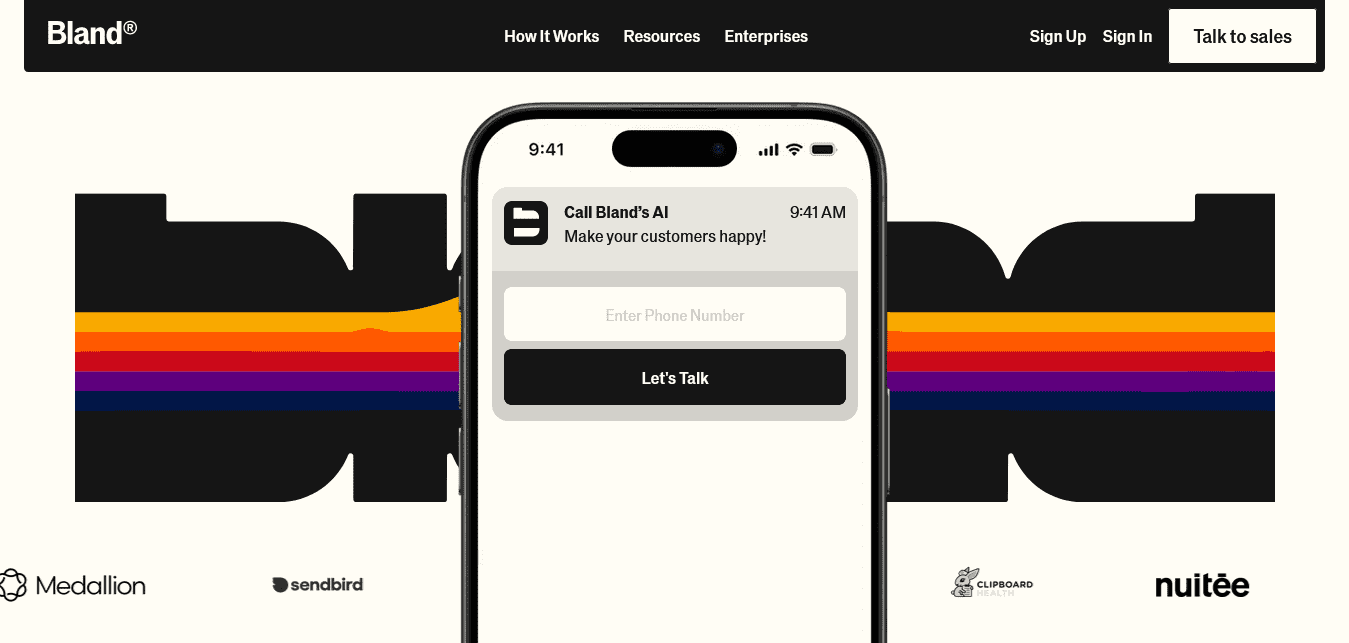
If your goal is to build hyper-personalized, voice-first AI experiences that feel as natural as speaking to a real person, then Bland AI is one of the best Voiceflow alternatives available today. Unlike platforms focused solely on text-based bots, Bland specializes in AI phone conversations that sound remarkably human, enabling businesses to connect with customers at every stage of their journey, whether it’s welcoming a new user, providing product support, or confirming appointments.
What makes Bland stand out is its laser focus on natural language phone communication. It offers a simple API and no-code integrations, allowing businesses to dispatch and receive AI-powered phone calls effortlessly. The conversational tone, speed, and emotion mimic a live agent, making it a powerful choice for customer-facing scenarios.
Pros of Bland AI
- Excellent voice quality and natural conversation flow
- Fully customizable via API
- No base fees; pay only for what you use
- Highly effective for customer engagement and sales follow-ups
- Great for businesses seeking conversational voice automation
Cons of Bland AI
- Not designed for chatbot or visual interface use
- May require technical knowledge for API-based customizations
- Lacks a broader UI for managing multichannel bots
3. Dialogflow
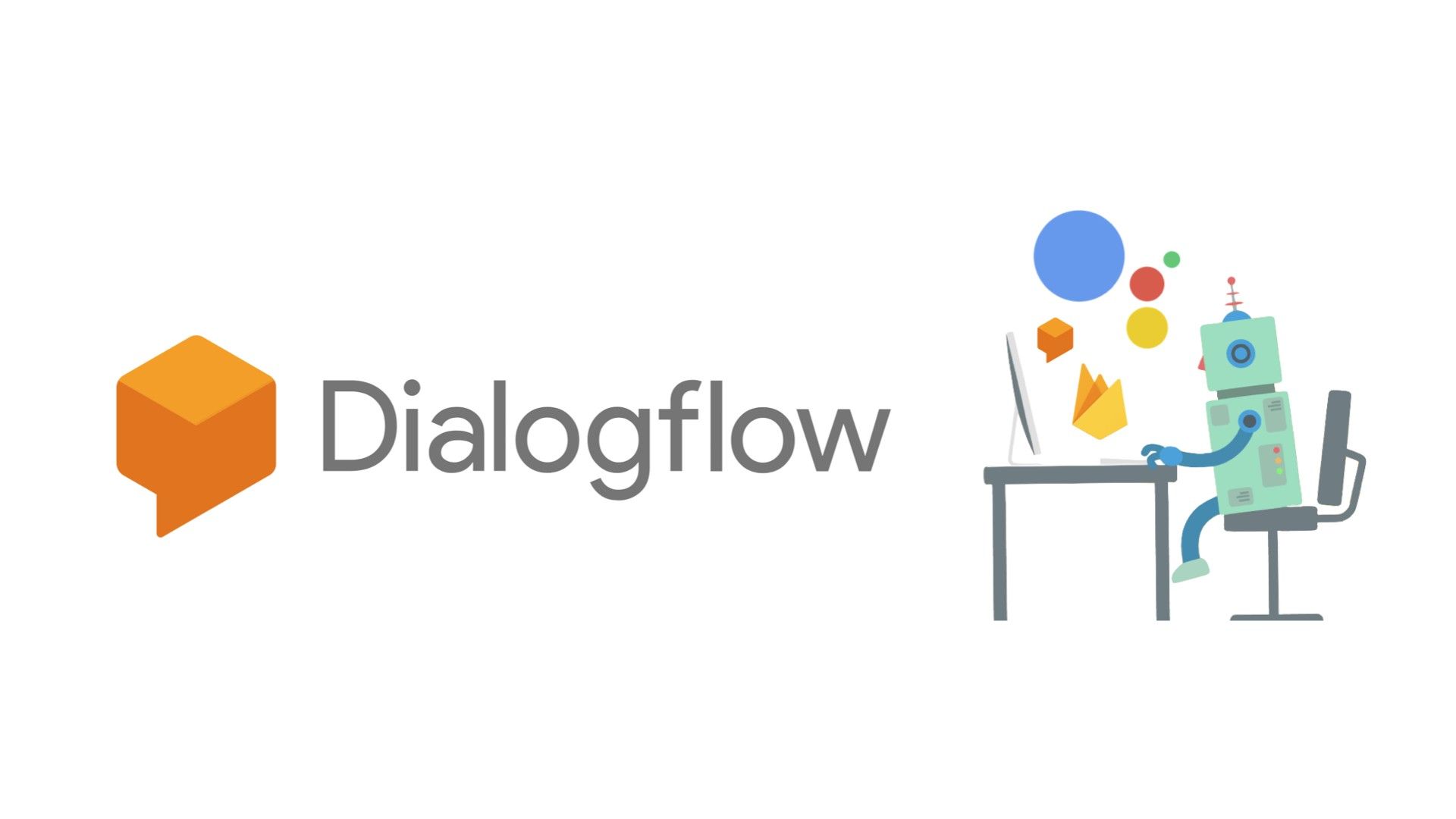
Dialogflow, developed by Google, is another powerful name in the AI automation space. It’s been around for years and is known for offering robust tools for creating intelligent chat and voice bots. If you’re a large organization looking for a secure, highly integrative AI solution, Dialogflow might be the right fit among the leading Voiceflow alternatives.
The platform supports multilingual conversations and can be deployed across various platforms including web, phone, and social channels. While Voiceflow AI provides a more visual, user-friendly environment for building flows, Dialogflow shines when it comes to deep integration with Google’s cloud ecosystem, real-time analytics, and flexibility.
Pros of Dialogflow
- Enterprise-ready infrastructure with strong cloud integration
- Flexible and scalable for large-scale implementations
- Rich intent recognition and NLP capabilities
- Strong developer ecosystem
- Works well for omnichannel customer support
Cons of Dialogflow
- Voice responses often sound robotic or unnatural
- Pricing is usage-based and can become expensive
- Can be overwhelming for non-developers
- May require additional tools to build visual flows like Voiceflow AI
4. Botpress
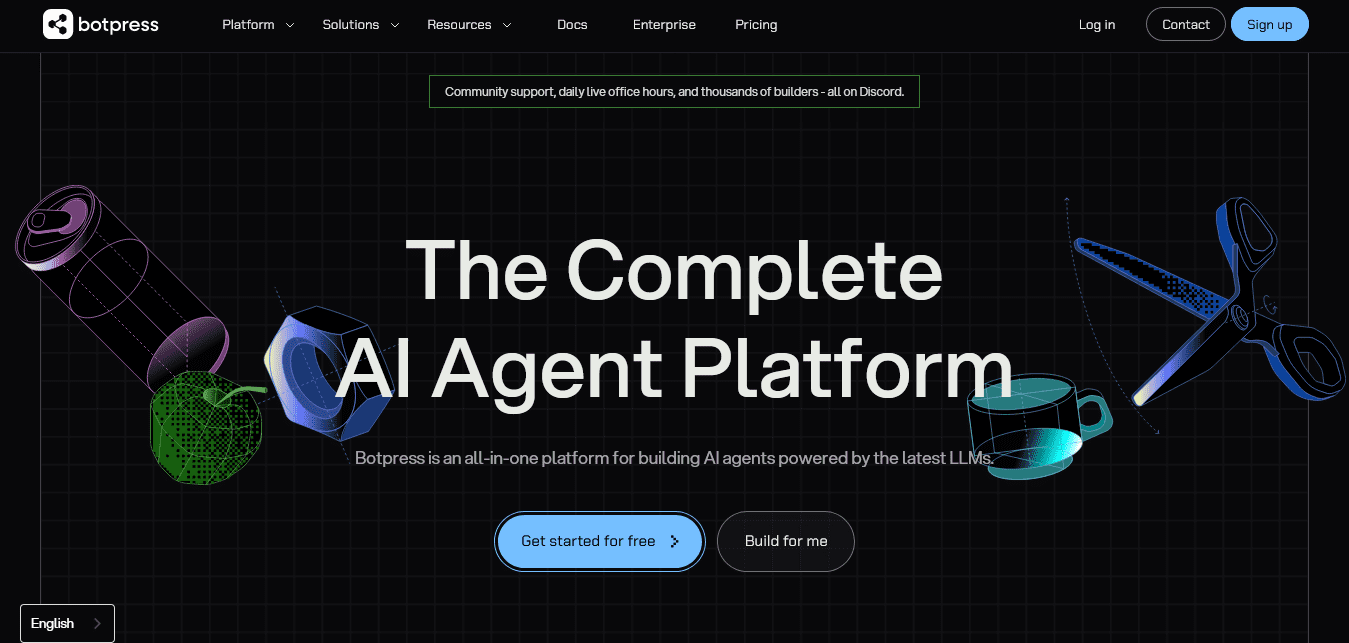
If you’re looking for a platform to quickly launch a ChatGPT-style bot on your website without the technical hassle, Botpress is a solid contender in the list of Voiceflow alternatives. Built with simplicity and efficiency in mind, Botpress makes it easy to train a chatbot using your business content and deploy it where your users are, on websites, apps, or messaging platforms.
Its drag-and-drop interface makes onboarding a breeze, even for non-technical users. You can upload documents, connect existing databases, and set up your custom AI assistant in just a few steps. Botpress focuses on delivering accurate responses for customer queries, support tickets, or internal FAQs.
Pros of Botpress
- Very easy to use for beginners and small teams
- Fast deployment and lightweight setup
- Offers detailed analytics and bot performance tracking
- Flexible integration options with popular tools
- Ideal for startups and internal automation
Cons of Botpress
- No voice support; text-only AI experiences
- Limited personalization and emotional intelligence
- Can get costly with high usage (up to $1000/month)
- May not scale as well for enterprise environments
5. Lindy
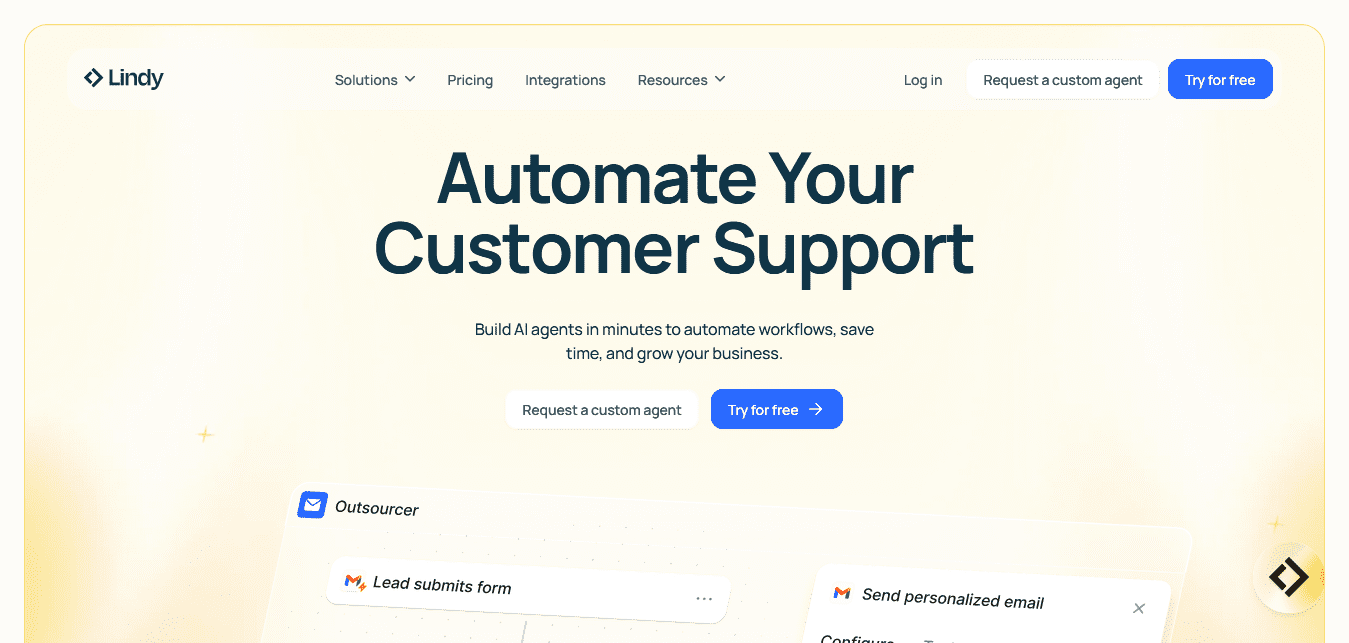
Lindy is a powerful AI automation platform built for teams that need more than just a chatbot. Unlike tools that focus on basic conversational flows, Lindy enables users to build intelligent agents that can handle real business tasks, like meeting scheduling, lead follow-ups, customer service, and even sales assistance. Its no-code visual interface makes it easy for non-technical users to create and launch advanced AI workflows without writing a single line of code.
One reason Lindy stands out among Voiceflow alternatives is its focus on practical business applications beyond messaging. Whether you’re automating internal workflows or building voice/chat agents for external use, Lindy’s flexible platform is designed to save time, reduce manual work, and improve efficiency across departments.
Pros of Lindy
- Versatile AI agents for a wide range of business tasks
- Easy to customize and scale with minimal effort
- Works well for small teams and growing businesses
- Provides voice-based automation as well as chatbot flows
Cons of Lindy
- Integration with niche or custom platforms may require extra setup
- Advanced workflows might have a learning curve for new users
6. Uchat
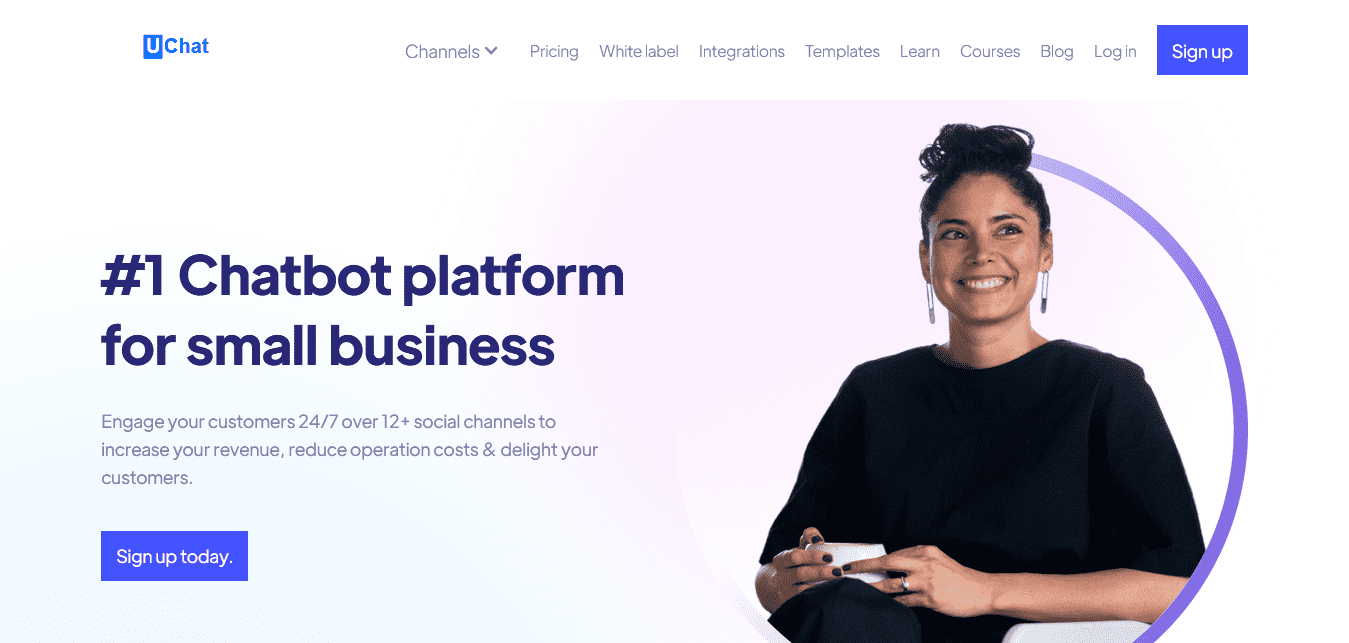
Uchat is a practical and budget-friendly platform tailored for small to mid-sized businesses looking to offer responsive, AI-driven customer support. With support for over 12 different channels, including WhatsApp, Messenger, Instagram, SMS, and web, Uchat gives businesses a central place to create and manage conversations across platforms.
The standout feature is its visual drag-and-drop flow builder, which makes setting up complex bot workflows feel simple. Uchat also provides AI-powered understanding to handle customer questions intelligently, making it one of the more user-friendly Voiceflow alternatives on the market today.
Pros of Uchat
- Live chat and AI combined in one tool
- Supports many messaging channels
- Simple to set up and operate
- Great value for small teams and solopreneurs
Cons of Uchat
- Analytics and reporting features are limited
- Widget design options could be improved
- Some advanced AI features require third-party plugins
7. Tidio
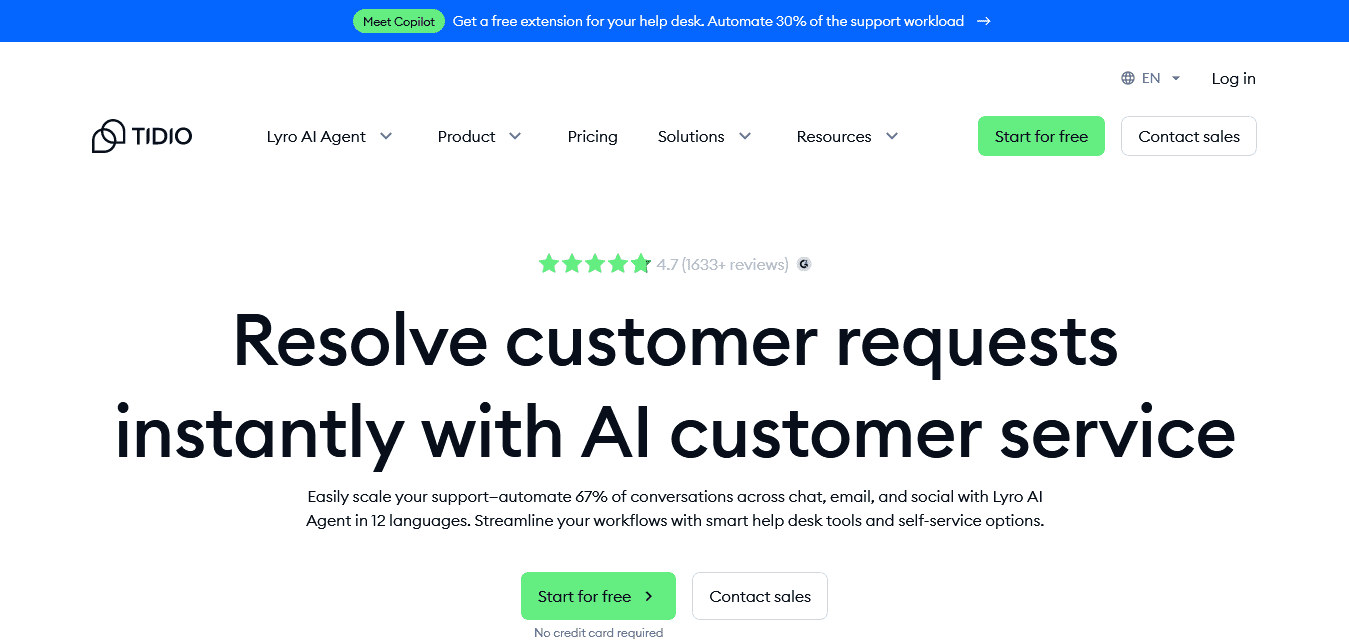
Tidio is a hybrid platform that blends live chat with AI-powered automation, designed specifically to help small and mid-sized businesses deliver faster and more efficient customer support. One of its best features is the real-time visitor tracking, which allows businesses to see who’s on their site and automatically initiate conversations based on user behavior.
As a Voiceflow AI alternative, Tidio doesn’t offer voice capabilities, but it shines when it comes to e-commerce support. With native integrations for Shopify, WooCommerce, and other platforms, it’s especially useful for online stores that want to automate FAQs, upsells, and order tracking, all while still offering the option to connect to a live human agent.
Pros of Tidio
- Smooth handoff between bot and human agents
- Ideal for online stores and customer service teams
- Customizable chatbot templates for fast setup
- Unified interface for managing all conversations
Cons of Tidio
- Multilingual support is limited
- Advanced AI automation is locked behind higher-tier plans
- Not suited for voice-based customer service workflows
8. Intercom
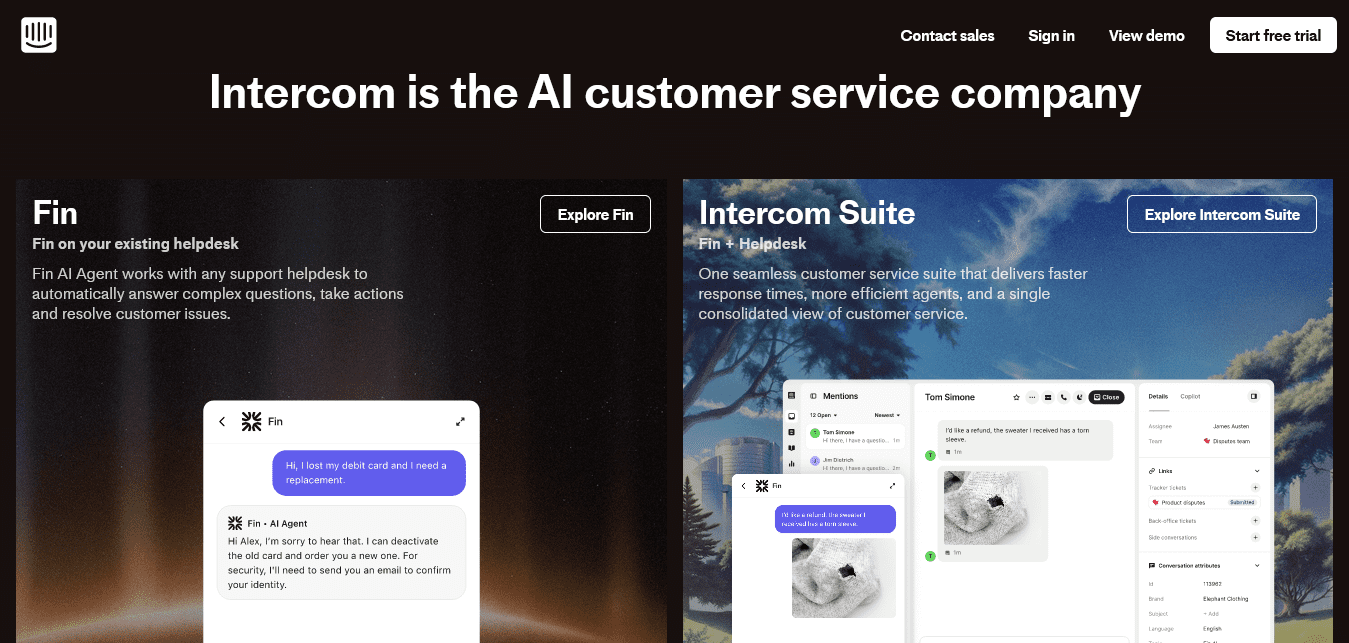
If you’re looking for a sophisticated customer messaging system that combines AI bots, live chat, and helpdesk tools in one ecosystem, Intercom is one of the most comprehensive Voiceflow alternatives available. It’s widely used by SaaS companies and large customer support teams who want to deliver personalized experiences at scale.
Intercom’s Resolution Bot can automatically answer common questions and escalate more complex issues to the right team member. Its proactive messaging features also allow businesses to send targeted messages based on customer behavior, location, or lifecycle stage.
Pros of Intercom
- Highly scalable with rich automation tools
- Combines several support tools in a single dashboard
- Strong analytics and performance tracking
- Great for SaaS and tech-focused teams
Cons of Intercom
- Pricing can increase rapidly with usage
- Steep learning curve for non-technical users
- Many premium features are paywalled on higher-tier plans
Alternatives Table
Tool Name |
Best For |
Starting Price |
Live Chat Support |
White Label |
Additional Highlights |
Rating |
GPTBots |
Enterprises needing scalable, compliant AI solutions trained on proprietary data |
Contact sales (custom pricing) |
Yes |
Yes |
End-to-end solution for regulated industries with measurable ROI |
4.8 |
Bland AI |
Personalized AI phone calls for customer engagement |
$0.07/min (usage-based) |
No |
Limited |
Sub-second response, API-first, great for outbound/inbound calls |
4.4 |
Dialogflow |
Google Cloud users & enterprises needing flexible NLP bots |
Usage-based (variable) |
Limited |
No |
Deep Google integrations, multilingual, developer-friendly |
4.3 |
Botpress |
Quick chatbot deployment with ChatGPT-style responses |
Free plan; usage-based up to $1,000/month |
No |
No |
20+ integrations, easy builder, no voice support |
4.1 |
Lindy |
Internal automation, voice agents & business task delegation |
Custom pricing |
Yes |
Limited |
AI assistants for scheduling, lead gen, and support |
4.5 |
Uchat |
Small businesses wanting affordable omnichannel bots |
Free; Business at $15/month
|
Yes |
No |
Supports 12+ channels, visual builder, live chat included |
4.2 |
Tidio |
E-commerce and SMBs combining chatbots with live support |
$24.17/month |
Yes |
No |
Real-time visitor tracking, ready-made templates |
4.4 |
Intercom |
SaaS companies needing smart messaging, CRM, and automation |
$39/month (Essential) |
Yes |
Limited to enterprise |
Robust targeting, helpdesk, bots, and CRM tools in one |
4.6 |
Final Thoughts
After exploring the platform’s features, pricing, limitations, and top alternatives, it’s clear that Voiceflow AI is a powerful no-code tool, particularly for teams focused on designing conversational flows for chat and voice agents. Its user-friendly interface, collaboration tools, and flexibility make it ideal for prototyping and deploying chatbots quickly without coding knowledge.
However, while Voiceflow excels in user experience and design, it struggles to deliver end-to-end, scalable deployment, especially for enterprise-grade use cases or regulated industries like healthcare, finance, or government. These sectors require more than visual editors; they need secure infrastructure, advanced data handling, dedicated support, and clear ROI measurement, areas where Voiceflow has its limitations.
That’s why we’ve highlighted some of the best Voiceflow alternatives for 2025; ranging from enterprise-level platforms like GPTBots to small-business-friendly solutions like Uchat and Tidio. These tools fill the gaps left by Voiceflow by offering:
- Better scalability and deployment capabilities
- More robust live chat and CRM integrations
- Support for omnichannel or voice-first experiences
- Dedicated support and white-labeling options (in selected platforms)
- Flexible or usage-based pricing models to match your growth
Whether you’re a small startup just starting to automate customer conversations, or a large organization in need of enterprise-grade AI agents with proprietary training and measurable impact, there’s a strong Voiceflow alternative out there to meet your specific needs.
So, What Should You Do Next?
Use Voiceflow AI if you’re just getting started with bot creation and want a fast, no-code solution for prototyping voice and chat agents.
Explore alternatives, like GPTBots, if you need more depth; be it in data integration, analytics, voice personalization, or long-term scalability.
In 2025, the conversational AI space is more competitive, and more exciting, than ever. Choosing the right platform doesn’t just depend on features. It’s about how well the tool fits into your tech stack, your customer journey, and most importantly, your business goals.
Get a Custom Demo


